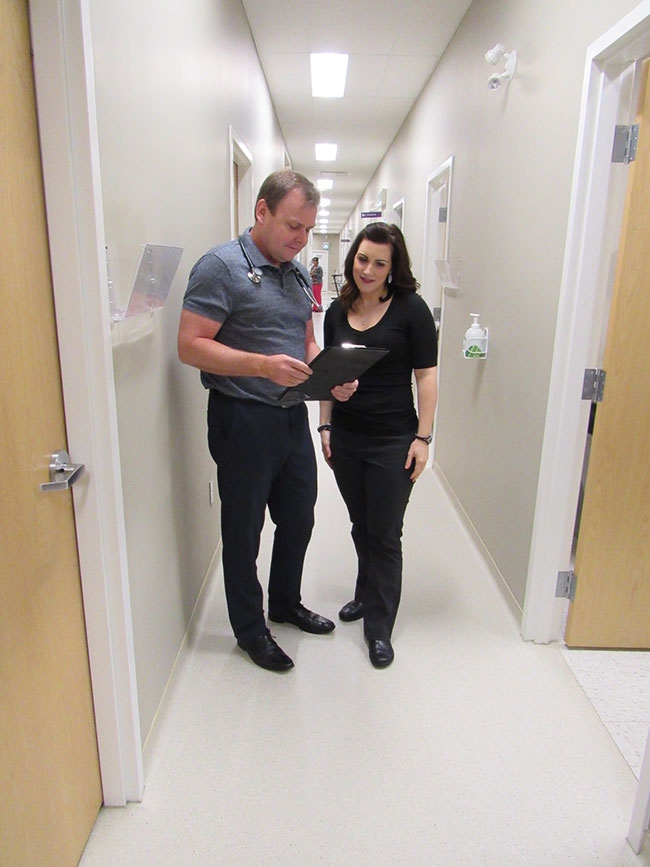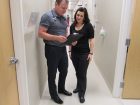
Partners in health
Mari-Len De
Features Collaboration ProfessionSmall-town cooperation that’s big on patient care
 Dr. John Butler (left) confers with chiropractor Dr. Lisa Thompson, who takes on patient referrals from family doctors in the community. Photo: Petrolia Chiropractic
Dr. John Butler (left) confers with chiropractor Dr. Lisa Thompson, who takes on patient referrals from family doctors in the community. Photo: Petrolia ChiropracticThe town of Petrolia, Ont. – just outside Sarnia – may have got its name from its reputation as a pioneer of the oil industry in North America, but the innovative efforts of its local doctors are making a mark in the health care realm.
With a population of less than 6,000, Petrolia’s Central Lambton Family Health Team is the community’s go-to for varied primary care services. And thanks to interprofessional, collaborative work that exists among health care practitioners in town, residents are able to access other needed health services outside the family health team more expediently.
“There’s been a general change in collaborative care in medicine and sharing care and working at different people’s skillsets,” explains Dr. John Butler, a family physician at the Central Lambton Family Health Team.
Butler began his medical career in 2001, at a time when family doctors typically had full autonomy over their patients’ medical care, and extensive collaboration with other health providers was not the norm. The evolution in health care through the 21st century, however, has been moving toward interprofessional collaboration and patient-centred care. Many of today’s medical practitioners are beginning to recognize and adapt to these changes.
“Over time, we began to learn that there’s more enhanced skills in many different areas. I was very reluctant to support nurse practitioners 15 years ago, but now they are part of our collaborative care, and I fully support and work with them,” says Butler, who in 2015 received the Outstanding Physician Award from Bluewater Health, the main hospital system serving the Sarnia-Lambton area.
Patient outcomes have also generally been satisfactory, comments Dr. Firas Al-Dhaher, also a family physician at Central Lambton Family Health Team. For example, he and Butler note patients with low-back pain and other musculoskeletal issues whom they have referred to the chiropractors at Petrolia Chiropractic are reporting good outcomes.
“Quite a bit of our patients are blue-collar workers – farmers, truck drivers – they do a lot of manual labour that expose them to musculoskeletal pathology,” Al-Dhaher says. “Knowing what approach those chiropractors do, I feel comfortable sending my patients to them so they can get their early onset assessments, and then I can follow up with them.”
Drs. Lisa Thompson and Amanda Core, the two chiropractors from Petrolia Chiropractic, have been engaging in collaborative patient care with the family doctors at Central Lambton Family Health Team over the last three years.
“The family health team out here is all about collaborating with different professionals, to really reduce wait times,” says Thompson, pointing out that with family doctors’ busy schedules, it’s important that they are able to confidently refer patients with mechanical low back pain, for example, to allied health practitioners like chiropractors.
“We just feel very strongly that we need to work together… There’s no power struggle about who owns the patient,” Thompson adds.
Patience is virtue
Getting referrals from the family doctors has not always been the case for the chiropractors. For Thompson, who started Petrolia Chiropractic 11 years ago, it took many years of consistent – mostly one-way – communication with the medical doctors, updating them about the status of a patient.
From the time she opened up her practice, Thompson has resolved to do what she can to try and foster a relationship with the town’s medical doctors. So whenever she would see a patient in her clinic, she makes sure she sends a note, via fax message, to the patient’s family doctor to keep him or her in the loop about the patient’s care – the diagnoses, treatment plan and whether she believes the patient needs a referral to another specialist.
“I did that for many years, but I never knew if there was any response. So I didn’t know how well things were really received,” Thompson says, but she was determined to keep doing the deed – not just as a means to introduce her practice to the medical doctors, but also for her patients as well. “We were tired of having our patients feel like they couldn’t tell their doctors that they were seeing us. It was quite silly, actually.”
So she took a few minutes at the end of every day to write her patient notes to the family doctors.
Core joined Thompson’s practice two years ago, shortly after graduating from New York Chiropractic College, but she’s very familiar with the clinic and Thompson’s practice of sending notes to the medical doctors about their patients. In fact, Core used to fax those letters to the doctors’ offices years before she even started chiropractic school.
Core used to work part-time at Thompson’s chiropractic clinic when she was in high school. “That’s when I kind of got interested in the whole chiropractic field.”
It was only about three years ago that Thompson finally got confirmation that her letters were not ending up in the recycling bin.
“It was Dr. Al-Dhaher calling my office to congratulate me on a case that I had worked on,” Thompson recalls. It turned out one of Al-Dhaher’s patients came in telling him about the chiropractic care she had received from Thompson.
Butler was hearing similar things from his patients who have gone to see Thompson.
“Not long after Dr. Thompson came to our town and opened up her practice, I noticed a number of my patients reported to me they had gone to her for their back pain,” says Butler, who admits he had reservations about chiropractic in the early years of his medical practice. “The thing that got to me was the patients were saying (Thompson) spent a long time with them, she took a history of pain, she did a physical examination and she provided her treatment.”
The initial phone conversation between Thompson and Al-Dhaher, and the subsequent meetings with the doctors and staff at the Central Lambton clinic essentially confirmed that Thompson’s efforts sending patient notes to the doctors did not go unnoticed and were, in fact, appreciated. More importantly, it also instigated what would be a steady patient referral stream coming from the clinic’s family doctors.
This new collaborative environment paved the way for more discussions about patient management and the progress of treatments. The doctors also find they could easily talk to each other about research and evidence-based practice.
It also provided an opportunity for the chiropractors to have open conversations with the medical doctors about chiropractic in general, and break down some misperceptions they may have about the profession.
“I think their eyes were opened to really see what our education was like and what we do treat,” says Thompson, who graduated from Canadian Memorial Chiropractic College. One area of concern was in cervical adjustments, she says, as doctors relayed stories from their patients who would go to a chiropractor for low back pain and they would leave having their neck adjusted. Thompson and his associate, Dr. Amanda Core, explained that is not how they practice.
“I knew we had to talk about it… and we had a good conversation about cervical spine adjusting – who it is suitable for, who it is not,” Thompson says.
Frequency of care was another question doctors posed, noting some chiropractors will require patients to book multiple visits.
“We let them know that our professional association does not support that type of care program, that we do promote evidence-based medicine, having re-evaluation and making sure that people are making progress,” Thompson says.
The patient referrals that have steadily come from the family health clinic to Thompson’s chiropractic office are indications of the medical doctors’ confidence in their care protocols.
The family health team had even made the process easier for medical doctors to refer patients to the chiropractors, Thompson explains. Soon after the chiropractors met with the family doctors, the clinic’s administration added the chiropractic clinic to the patient referral feature in its electronic health system that allows the physician to facilitate a referral just by simply clicking a button on the screen.
That button initiates a message sent to Thompson’s clinic with the treatment request, the patient’s information and pertinent diagnosis. Thompson’s office then contacts the patient to book an appointment.
“It’s a nice, smooth transition, very patient-friendly,” Thompson says. “(The patient) now feels like they don’t just have one person looking after them but it’s a team approach.”
Butler and Al-Dhaher say they would typically refer patients with mechanical back pain, sciatica and various musculoskeletal conditions.
“Most recently, I’ve had patients with osteoarthritis of the neck – so the cervical spine,” Al-Dhaher recollects. “When we had Dr. Core and Dr. Thompson come over and we expressed our concerns about osteoarthritis of the neck, they were able to show us journal articles, peer-reviewed journals that demonstrate the effectiveness of chiropractic techniques on neck pain.
“By sharing that with us, we feel much more comfortable in having our patients referred and receive that sort of care at their clinic.”
Patient outcome
Tressa Brown, a school teacher, came to see Al-Dhaher about a persistent back and neck pain. At that time, the family health team just started engaging with the chiropractors and upon hearing Brown’s complaints, he readily suggested chiropractic care.
She was impressed at how well Al-Dhaher and Thompson worked together to address her health issues.
“Dr. Al-Dhaher really talked it up like, ‘this is going to work,’” recalls Brown who, at the time was in a lot of pain so Al-Dhaher called up Thompson to get an appointment right away.
“It ended up being one of the most efficient medical treatments I’ve ever received,” Brown says, adding she felt that both doctors were treating her as a “whole person” not just her symptoms.
Brown had also no idea the chiropractic referral would be a catalyst that would send her down the path of better health and wellness. More than a year had passed since she last received chiropractic care, she is pain-free, exercising regularly and have lost 40 lbs.
“Dr. Thompson had been my inspiration,” Brown says. “She suggested healthy eating and she also talked about exercise…. Now I’ve dropped 40 lbs. and I’m healthy and active.
“(Dr. Thompson’s) efficiency in how she dealt with this acute pain I was in has been what made me ready to make the next change in my life.”
Butler’s patient, Rita Paget, was experiencing significant neck pain when he recommended chiropractic care, and referred her to Core. It was Paget’s first time seeing a chiropractor.
She says after three or four chiropractic sessions with Core and some acupuncture treatments, her condition has improved and her neck pain was resolved.
Paget commends the “team effort” of the doctors involved in her care.
“It’s nice to know that it’s a team effort as opposed to you making those decisions on your own, trying different techniques and different strategies on your own. At least you know that all your health team is consulting with one another and they are working holistically for you,” she says.
Education
In addition to referring patients Al-Dhaher has also invited the chiropractors to conduct information sessions with the staff and learners (medical students) at the Central Lambton Family Health clinic, which also serves as a training site for medical students from Western University.
These education sessions provided further opportunity for Thompson and Core to educate other health care workers and future doctors about chiropractic. In one occasion, they came in with their chiropractic table allowing them to demonstrate their process for assessment and adjustment techniques.
Al-Dhaher says that goes a long way for the clinic staff and medical residents.
“Not only are they educated to see what (the chiropractors) provide, but they can also bring that back to their patients and say, ‘I’ve seen the chiropractor do this on my colleague, and this is what you should expect.’ Everybody benefits from that sort of exposure,” explains Al-Dhaher, whose work in training and mentoring medical students at the Central Lambton clinic recognized by the Ontario College of Family Physicians. Last year, Al-Dhaher was the recipient of the college’s Award of Excellence.
Both Al-Dhaher and Butler believe interprofessional collaboration works well when it starts at the education level. It’s part of the reason why Al-Dhaher invites speakers from other health professions in the community to come and talk to the residents.
Al-Dhaher says he is a big proponent of interprofessional education.
“There’s been a paradigm shift in medical education,” says Al-Dhaher. “Our most recent young learners, medical students and residents are being now exposed to allied health and some of the things and the scope that they bring to the table.”
Patient education, self-care and promoting wellness outside of clinical care are other areas where the chiropractors are scoring some health care points, according to Butler.
The 10-week Learn to Run course that both Thompson and Core conduct in partnership with the family health team, has been a great example of community programs that promote better health and disease prevention.
Butler recently participated in that running program.
“When you have people building a healthy community beyond just seeing the person in the office, that is something that I respect,” Butler says. “I’ve spent a big chunk of my career trying to enhance the infrastructure of health in our community beyond just my own clinic, and then I see someone like Dr. Thompson running groups to get people out and around town. It’s a dynamic change of attitude about health.”
As a relatively new chiropractor, Core feels “very fortunate” to be learning from and working with Thompson and experiencing first-hand at such early stage in her career what many believe is the future of health care: interprofessional collaboration.
“I’ve been really lucky to have that opportunity, and I realize not every new grad does. It takes a lot of time to build that trust that (Thompson) spent over 10 years doing already. It made my job a little easier,” Core says.
MARI-LEN DE GUZMAN is the editor of Canadian Chiropractor magazine. She has worked in publishing for 20 years and has been editor of several business and professional magazines. You may contact her at mdeguzman@annexweb.com.
Print this page


